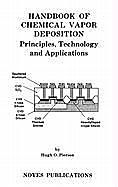Handbook of Chemical Vapor Deposition
Einband:
Fester Einband
EAN:
9780815513001
Untertitel:
Principles, Technology and Applications
Autor:
Hugh O. Pierson
Herausgeber:
Elsevier Science & Technology
Auflage:
New.
Anzahl Seiten:
458
Erscheinungsdatum:
1999
ISBN:
978-0-8155-1300-1
Handbook of Chemical Vapor Deposition: Principles, Technology and Applications provides information pertinent to the fundamental aspects of chemical vapor deposition. This book discusses the applications of chemical vapor deposition, which is a relatively flexible technology that can accommodate many variations. Organized into 12 chapters, this book begins with an overview of the theoretical examination of the chemical vapor deposition process. This text then describes the major chemical reactions and reviews the chemical vapor deposition systems and equipment used in research and production. Other chapters consider the materials deposited by chemical vapor deposition. This book discusses as well the potential applications of chemical vapor deposition in semiconductors and electronics. The final chapter deals with ion implantation as a major process in the fabrication of semiconductors. This book is a valuable resource for scientists, engineers, and students. Production and marketing managers and suppliers of equipment, materials, and services will also find this book useful.
Autorentext
Hugh Pierson is a private consultant in Chemical Vapor Deposition. He was the head of the Deposition
Klappentext
A comprehensive overview of the principles, technology and application of chemical vapor deposition (CVD), an extremely versatile process which can be used to manufacture coatings, powders, fibers and monolithic components. It presents a clear, objective, systematic assessment of CVD, including an examination of the theory of CVD processes, descrip
Inhalt
?1. Introduction and General Considerations 1.0 Introduction 2.0 Historical Perspective 3.0 The Applications of CVD 4.0 CVD Coatings 4.1 Composite Nature of Coatings 4.2 Major Coating Processes 5.0 Profile of the CVD Industry 6.0 Trends in CVD 7.0 Book Objectives References2. Fundamentals of Chemical Vapor Deposition 1.0 Introduction 2.0 Thermodynamics of CVD 2.1 ?G Calculations and Reaction Feasibility 2.2 Thermodynamic Equilibrium and Computer Programs 3.0 Kinetics and Mass Transport Mechanisms 3.1 Deposition Sequence 3.2 Deposition in a CVD Flow Reactor 3.3 Rate Limiting Steps 3.4 Mathematical Expressions of the Kinetics of CVD 4.0 Growth Mechanism and Structure of Deposit 4.1 Deposition Mechanism and Epitaxy 4.2 Structure and Morphology of CVD Materials 4.3 The Control of CVD Microstructure References3. The Chemistry of CVD 1.0 Categories of CVD Reactions 1.1 Thermal Decomposition (or Pyrolysis) Reactions 1.2 Hydrogen Reduction 1.3 Coreduction 1.4 Metal Reduction of the Halides 1.5 Oxidation and Hydrolysis Reactions 1.6 Reactions to Form Carbides and Nitrides 2.0 CVD Precursors 3.0 Halides 3.1 Halogens 3.2 Halide Formation or Halogenation 3.3 Halide Properties 4.0 Metal Carbonyls 4.1 Characteristics of the Carbonyls 4.2 Carbonyl Preparation 4.3 Metal Carbonyl Complexes 5.0 Metallo-Organic Precursors 5.1 Alkyls 5.2 Acetylacetonates 6.0 Hydrides References4. CVD Processes and Equipment 1.0 Introduction 2.0 Open and Closed Reactor Systems 3.0 Reactant Supply 3.1 Reactant Transport 3.2 Reactant Purity and Contamination 4.0 Thermal CVD: Deposition System and Reactor 4.1 Heating Methods 4.2 Atmospheric and Low Pressure Reactors 5.0 Exhaust and By-Product Disposal 6.0 Plasma CVD 6.1 Principles of Plasma Deposition 6.2 Characteristics of the Plasma CVD Process 6.3 Materials Deposited by Plasma CVD 6.4 Plasma CVD Equipment 7.0 Laser and Photo CVD 7.1 Laser CVD 7.2 Photo CVD 8.0 Metallo-Organic CVD (MOCVD) 9.0 Chemical Vapor Infiltration (CVI) 10.0 Fluidized-Bed CVD References5. The CVD of Metals 1.0 Introduction 2.0 Aluminum 2.1 CVD Reactions 2.2 Applications 3.0 Beryllium 3.1 CVD Reactions 3.2 Applications 4.0 Cadmium 4.1 CVD Reactions 5.0 Chromium 5.1 CVD Reactions 5.2 Applications 6.0 Copper 6.1 CVD Reactions 6.2 Applications 7.0 Gold 7.1 CVD Reactions 7.2 Applications 8.0 Iridium 8.1 CVD Reactions 8.2 Applications 9.0 Iron 9.1 CVD Reaction 9.2 Applications 10.0 Molybdenum 10.1 CVD Reactions 10.2 Application 11.0 Nickel 11.1 CVD Reactions 11.2 Applications 12.0 Niobium (Colombium) 12.1 CVD Reactions 12.2 Applications 13.0 Platinum 13.1 CVD Reactions 13.2 Applications 14.0 Rhenium 14.1 CVD Reactions 14.2 Applications 15.0 Rhodium and Ruthenium 15.1 CVD Reactions 15.2 Applications 16.0 Tantalum 16.1 CVD Reactions 16.2 Applications 17.0 Tin 18.0 Titanium 18.1 CVD Reactions 18.2 Applications 19.0 Tungsten 19.1 CVD Reactions 19.2 Applications 20.0 Intermetallics 20.1 Titanium Aluminides 20.2 Ferro Nickel 20.3 Nickel-Chromium 20.4 Tungsten-Thorium 20.5 Niobium-Germanium References6. The CVD of Non-Metallic Elements and Semiconductors 1.0 Introduction 2.0 Boron 2.1 CVD R

Leider konnten wir für diesen Artikel keine Preise ermitteln ...
billigbuch.ch sucht jetzt für Sie die besten Angebote ...
Die aktuellen Verkaufspreise von 6 Onlineshops werden in Realtime abgefragt.
Sie können das gewünschte Produkt anschliessend direkt beim Anbieter Ihrer Wahl bestellen.
Loading...
Die aktuellen Verkaufspreise von 6 Onlineshops werden in Realtime abgefragt.
Sie können das gewünschte Produkt anschliessend direkt beim Anbieter Ihrer Wahl bestellen.
| # | Onlineshop | Preis CHF | Versand CHF | Total CHF | ||
|---|---|---|---|---|---|---|
| 1 | Seller | 0.00 | 0.00 | 0.00 |
